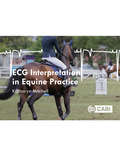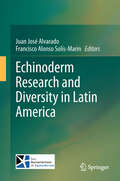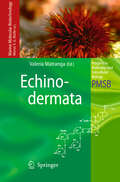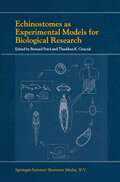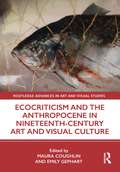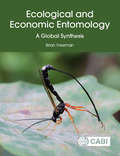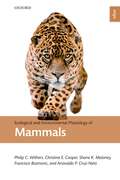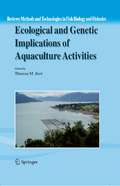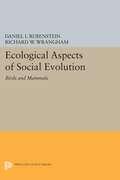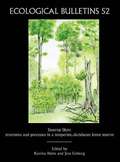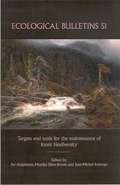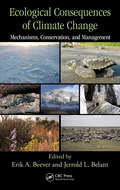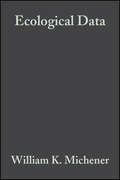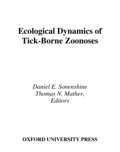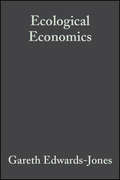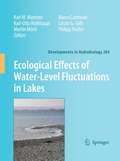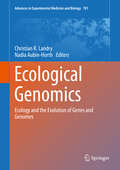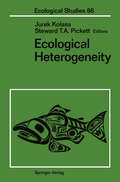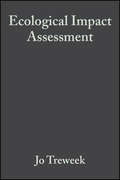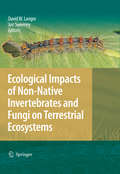- Table View
- List View
ECG Interpretation in Equine Practice
by Katharyn MitchellAdvances in veterinary medical technology now provide easier and more affordable access to equine ECG recording and transmitting equipment, making ECG recordings a useful tool for equine veterinarians in both field and hospital settings. Covering the basics of equine ECG recording, analyses and interpretation, this book provides a practical approach with details of how to get the most information out of your ECG recordings. The only book dedicated to equine ECGs, it includes: - Numerous clear ECG illustrations - Worked case examples to put theory into practice - New pharmacological therapies and interventional techniques A hands-on guide for veterinarians to use when recording, diagnosing and treating arrhythmias in horses, this book will be invaluable to both specialists and those who find themselves evaluating the occasional equine patient.
Echinoderm Research and Diversity in Latin America
by Juan José Alvarado and Francisco Alonso Solís-MarínThis book compiles for the first time the development of echinoderm research in Latin America. The book contains 17 chapters, one introductory, 15 country chapters, and a final biogeographic analysis. It compiles all the investigations published in international and local journals, reports, theses and other gray literature. Each chapter is composed of 7 sections: introduction describes the marine environments, and main oceanographic characteristics, followed by a history of research account divided by specific subjects. The next section addresses patterns of distribution and diversity. A specific section would explain fishery or aquaculture activities. The next sections deal with environmental and anthropogenic threats that are affecting echinoderm, and any conservation or management action. Finally, a section with conclusions, needs and new lines of research. The book will include two appendixes with species lists of all echinoderms with bathimetric data, habitat and distribution.
Echinodermata (Progress in Molecular and Subcellular Biology #39)
by Valeria MatrangaMembers of the phylum Echinodermata are among the most familiar marine invertebrates. Forms such as the sea star have become virtually a symbol of sea life. Used in ancient oriental medicine as a source of bioactive compounds, sea cucumbers, sea stars and sea urchins are now used for the extraction and purification of cytotoxic, haemolytic, antiviral, antifungal, antifouling, antimicrobial and even anti-tumoural activities. In addition, of the five extant classes, sea urchins and sea cucumbers are important economic resources for current fishery and aquaculture. Molecular and cell biological techniques described in this book are, on the one hand, indicative of the improvements made over the years and, on the other, stress the need of their further exploitation for the sustainable production of bioactive compounds and their application in biomedicine.
Echinostomes as Experimental Models for Biological Research
by Bernard Fried T. K. GraczykEchinostomes are ubiquitous intestinal flatworm parasites of vertebrates and are of importance in human and veterinary medicine and wildlife diseases. Echinostomes can be maintained easily and inexpensively in the laboratory and provide good models for biological research ranging from the molecular to the organismal. Considerable but scattered literature has been published on the subject of echinostomes and a synthesis of this wide range of topics has now been achieved with the publication of this book, which presents a wide range of topics in experimental biology related to the use of echinostomes as laboratory models. It will have a special appeal to advanced undergraduates and graduate students in parasitology and should also appeal to professional parasitologists, physicians, veterinarians, wildlife disease biologists, and any biomedical scientists interested in new model systems for studies in experimental biology.
Echo Come Home
by Megan Rix'I wish I had a dog . . . It could be a big dog or a little one. It could be any colour or breed. Just most of all I'd like a hearing dog.'Eleven-year-old Jake is dreading his new school. No one understands how hard it is for him to make friends.But then Jake meets Echo. Echo is a stray puppy, training to be a hearing dog. With Echo by his side, Jake's confidence grows.But then something terrible happens and Jake and Echo are separated. Determined to find his way back to Jake, Echo sets out on the difficult journey home.With a long road ahead and danger all around, have Jake and Echo lost each other forever?
Eclipse: The Story Of The Rogue, The Madam And The Horse That Changed Racing
by Nicholas CleeEpsom Downs, 3rd May, 1769: a chestnut with a white blaze scorches across the turf towards the finishing post. His four rivals are so far behind him that, in racing terms, they are 'nowhere'. Watching Eclipse is the man who wants to buy him. An adventurer who has made his money through roguery and gambling, Dennis O'Kelly is also the companion of the madam of one of London's most notorious brothels. While O'Kelly is destined to remain an outcast to the racing establishment, his horse will go on to become the undisputed, undefeated champion of his sport. Eclipse's male-line descendants will include Desert Orchid, Arkel and all but three of the Derby winners of the past fifty years. And his astonishing life will be matched only by that of the rogue who owned him.
Ecocriticism and the Anthropocene in Nineteenth-Century Art and Visual Culture (Routledge Advances in Art and Visual Studies)
by Maura CoughlinIn this volume, emerging and established scholars bring ethical and political concerns for the environment, nonhuman animals and social justice to the study of nineteenth-century visual culture. They draw their theoretical inspiration from the vitality of emerging critical discourses, such as new materialism, ecofeminism, critical animal studies, food studies, object-oriented ontology and affect theory. This timely volume looks back at the early decades of the Anthropocene to query the agency of visual culture to critique, create and maintain more resilient and biologically diverse local and global ecologies.
Ecocriticism and the Anthropocene in Nineteenth-Century Art and Visual Culture (Routledge Advances in Art and Visual Studies)
by Maura Coughlin Emily GephartIn this volume, emerging and established scholars bring ethical and political concerns for the environment, nonhuman animals and social justice to the study of nineteenth-century visual culture. They draw their theoretical inspiration from the vitality of emerging critical discourses, such as new materialism, ecofeminism, critical animal studies, food studies, object-oriented ontology and affect theory. This timely volume looks back at the early decades of the Anthropocene to query the agency of visual culture to critique, create and maintain more resilient and biologically diverse local and global ecologies.
Ecological and Economic Entomology: A Global Synthesis
by Brian FreemanEcological and Economic Entomology is a comprehensive advanced text covering all aspects of the role of insects in natural ecosystems and their impacts on human activity. The book is divided into two sections. The first section begins with an outline of the structure, classification and importance of insects, followed by the geographical aspects of plant distribution and the complex defences plants marshal against herbivorous insects. Insect pests affecting plant roots, stem, leaf, and reproductive systems are covered in a comprehensive review. This section also covers insects that are important in medical and veterinary science, paying particular attention to those that transmit pathogens. The section concludes with the beneficial aspects of insects, especially their use in biological control, but also as soil formers and their importance in forensic science. Autecology (or single-species ecology) and its application to pest management is the focus of the second section of the book. Firstly, some general aspects of autecology are examined, including species abundance, competition and speciation, and relevant genetics. The classic general theories of insect population dynamics are reviewed, followed by chapters on life tables, time series analysis and mathematical models in insect populations. The final chapter reviews the application of autecology to the insect pests of forests, farms and orchards and to the control of insect vectors of diseases of humans and livestock. Particular attention is paid to environmentally friendly methods of pest management and the application of Integrated Pest Management (IPM) techniques. This volume is essential reading for professional entomologists and advanced students of agricultural, medical and veterinary entomology, insect ecology and conservation.
Ecological and Environmental Physiology of Mammals (Ecological and Environmental Physiology Series)
by Shane K. Maloney Philip C. Withers Christine E. Cooper Francisco Bozinovic Ariovaldo P. Cruz NetoMammals are the so-called "pinnacle" group of vertebrates, successfully colonising virtually all terrestrial environments as well as the air (bats) and sea (especially pinnipeds and cetaceans). How mammals function and survive in these diverse environments has long fascinated mammologists, comparative physiologists and ecologists. Ecological and Environmental Physiology of Mammals explores the physiological mechanisms and evolutionary necessities that have made the spectacular adaptation of mammals possible. It summarises our current knowledge of the complex and sophisticated physiological approaches that mammals have for survival in a wide variety of ecological and environmental contexts: terrestrial, aerial, and aquatic. The authors have a strong comparative and quantitative focus in their broad approach to exploring mammal ecophysiology. As with other books in the Ecological and Environmental Physiology Series, the emphasis is on the unique physiological characteristics of mammals, their adaptations to extreme environments, and current experimental techniques and future research directions are also considered. This accessible text is suitable for graduate level students and researchers in the fields of mammalian comparative physiology and physiological ecology, including specialist courses in mammal ecology. It will also be of value and use to the many professional mammologists requiring a concise overview of the topic.
Ecological and Environmental Physiology of Mammals (Ecological and Environmental Physiology Series)
by Philip C. Withers Christine E. Cooper Shane K. Maloney Francisco Bozinovic Ariovaldo P. Cruz NetoMammals are the so-called "pinnacle" group of vertebrates, successfully colonising virtually all terrestrial environments as well as the air (bats) and sea (especially pinnipeds and cetaceans). How mammals function and survive in these diverse environments has long fascinated mammologists, comparative physiologists and ecologists. Ecological and Environmental Physiology of Mammals explores the physiological mechanisms and evolutionary necessities that have made the spectacular adaptation of mammals possible. It summarises our current knowledge of the complex and sophisticated physiological approaches that mammals have for survival in a wide variety of ecological and environmental contexts: terrestrial, aerial, and aquatic. The authors have a strong comparative and quantitative focus in their broad approach to exploring mammal ecophysiology. As with other books in the Ecological and Environmental Physiology Series, the emphasis is on the unique physiological characteristics of mammals, their adaptations to extreme environments, and current experimental techniques and future research directions are also considered. This accessible text is suitable for graduate level students and researchers in the fields of mammalian comparative physiology and physiological ecology, including specialist courses in mammal ecology. It will also be of value and use to the many professional mammologists requiring a concise overview of the topic.
Ecological and Genetic Implications of Aquaculture Activities (Reviews: Methods and Technologies in Fish Biology and Fisheries #6)
by Theresa M. BertIn this book, numerous prominent aquaculture researchers contribute 27 chapters that provide overviews of aquaculture effects on the environment. They comprise a comprehensive synthesis of many ecological and genetic problems implicated in the practice of aquaculture and of many proven, attempted, or postulated solutions to those problems. This is an outstanding source of reference for all types of aquaculture activities.
An Ecological and Societal Approach to Biological Control (Progress in Biological Control #2)
by J. Eilenberg Heikki M. T. HokkanenBiological control is among the most promising methods for control of pests, diseases and weeds, and this book treats ecological and societal aspects together for the first time. The aim is to evaluate the significance of certain biological properties like biodiversity and natural habitats. In a societal approach terms like ‘consumer’s attitude’, ‘risk perception’, ‘learning and education’ and ‘value triangle’ are recognized as significant for biological production and human welfare.
Ecological Aspects of Social Evolution: Birds and Mammals
by Daniel I. Rubenstein Richard W. WranghamSeeking common principles of social evolution in different taxonomic groups, the contributors to this volume discuss eighteen groups of birds and mammals for which long-term field studies have been carried out. They examine how social organization is shaped by the interaction between proximate ecological pressures and culture"--the social traditions already in place and shaped by local and phylogenetic history.Originally published in 1987.The Princeton Legacy Library uses the latest print-on-demand technology to again make available previously out-of-print books from the distinguished backlist of Princeton University Press. These editions preserve the original texts of these important books while presenting them in durable paperback and hardcover editions. The goal of the Princeton Legacy Library is to vastly increase access to the rich scholarly heritage found in the thousands of books published by Princeton University Press since its founding in 1905.
Ecological Bulletins, Suserup Skov: Structures and Processes in a Temperate, Deciduous Forest Reserve (Ecological Bulletins)
by Katrine Hahn Jens EmborgSuserup Skov in Denmark is a well-preserved beech-dominated forest reserve with continuity in tree cover at least back to 4200 BC, indicating it to be a direct descendent of the primeval forests. Despite of documented historical impact from humans, Suserup Skov is now increasingly characterized by natural disturbance dynamics and is one of the best reference areas for naturalness in the nemoral part of northern Europe. This has attracted several research projects focussing on forest dynamics, ecology and biodiversity which are summarized in this issue of Ecological Bulletins. This volume focuses on three main areas: 1) stand structures and dynamics 2) water and nutrient cycling processes, and 3) vegetation patterns and processes. With a compilation of scientific reviews, detailed case-studies and experimental works, the volume provides a unique and in-depth overview of structures and processes in a single forest reserve. The aim is to establish a basic reference of science and practice within forestry and nature conservation.
Ecological Bulletins, Targets and Tools for the Maintenance of Forest Biodiversity (Ecological Bulletins)
by Per Angelstam Monica Donz-Breuss Jean-Michel RobergeMaintaining forest biodiversity by combining protection, management and restoration of forest and woodland landscapes is a central component of sustainable development. Evidence that there are threshold levels for how much habitat loss may be tolerated for viable populations of specialised species to be maintained. Policy-makers, businesses and managers pose questions about how to balance use of renewable forest resources and conserve biodiversity. Examples are presented on how biodiversity assessments can be made. Proposes how the critical gaps in our knowledge identified throughout the book could be filled through macroecological research and international co-operation.
Ecological Consequences of Climate Change: Mechanisms, Conservation, and Management
by Erik A. Beever Jerrold L. BelantContemporary climate change is a crucial management challenge for wildlife scientists, conservation biologists, and ecologists of the 21st century. Climate fingerprints are being detected and documented in the responses of hundreds of wildlife species and numerous ecosystems around the world. To mitigate and accommodate the influences of climate ch
Ecological Data: Design, Management and Processing
by William K. Michener James W. BruntEcologists are increasingly tackling difficult issues like global change, loss of biodiversity and sustainability of ecosystem services. These and related topics are enormously challenging, requiring unprecedented multidisciplinary collaboration and rapid synthesis of large amounts of diverse data into information and ultimately knowledge. New sensors, computers, data collection and storage devices and analytical and statistical methods provide a powerful tool kit to support analyses, graphics and visualizations that were unthinkable even a few years ago. New and increased emphasis on accessibility, management, processing and sharing of high-quality, well-maintained and understandable data represents a significant change in how scientists view and treat data. These issues are complex and despite their importance, are typically not addressed in database, ecological and statistical textbooks. This book addresses these issues, providing a much needed resource for those involved in designing and implementing ecological research, as well as students who are entering the environmental sciences. Chapters focus on the design of ecological studies, data management principles, scientific databases, data quality assurance, data documentation, archiving ecological data and information and processing data into information and knowledge. The book stops short of a detailed treatment of data analysis, but does provide pointers to the relevant literature in graphics, statistics and knowledge discovery. The central thesis of the book is that high quality data management systems are critical for addressing future environmental challenges. This requires a new approach to how we conduct ecological research, that views data as a resource and promotes stewardship, recycling and sharing of data. Ecological Data will be particularly useful to those ecologists and information specialists that actively design, manage and analyze environmental databases. However, it will also benefit a wider audience of scientists and students in the ecological and environmental sciences.
Ecological Dynamics of Tick-Borne Zoonoses
by Daniel E. Sonenshine Thomas N. MatherThe ecological relationships found to exist between tick vectors and pathogens in their zootic cycle can profoundly influence patterns of transmission and disease for humans and domestic animals. This book examines the ecological parameters affecting the conservation and regulation of tick-borne zoonoses as well as the geographic and seasonal distributions of those infections. Written by an eminent authority on the subject, the book will be sought after by students and researchers in ecology, invertebrate zoology, parasitology, entomology, public health, and epidemiology.
Ecological Economics: An Introduction
by Gareth Edwards-Jones Ben Davies Salman S. HussainEcological economics is an exciting interdisciplinary field of study that combines insights from the natural sciences, economics, philosophy and other fields to develop innovative approaches to environmental problems. It draws on a wide range of analytical perspectives, some radical others more conventional, to build a more complete understanding of human-ecosystem interactions. Current research in the field includes work on nature conservation, land use planning, pollution control, natural resource management, and environmental impact assessment/evaluation. Ecological Economics provides a comprehensive introduction to the core themes, presented in a clearly structured style, with chapters tailored specifically to readers without any economic or philosophical training. There is an emphasis throughout on the complementary roles of economics, ethics and ecology in environmental decision-making processes. The book reviews the evolution of important ideas in the field, explores the fundamental philosophies underlying different approaches to environmental problems, explains in detail the specific tools and techniques used in these approaches, and gives numerous examples of how they can be applied. Special importance is attached to understanding both the advantages and limitations of different analyses, in order to provide a balanced and coherent view of how these different approaches interrelate and how their roles vary in different contexts. Written by three authors specializing in ecology, economics and philosophy, this textbook provides an excellent introduction to the field of ecological economics for students in the natural sciences and other environmental disciplines. It will also be of interest to a wide range of professionals and researchers involved in environmental management and policy, and thers including economists seeking to broaden their knowledge of new methodologies and approaches. Further reading suggestions and extensive references are provided for those interested in pursuing particular themes beyond the introductory level. The first introductory ecological economics text written specifically for natural scientists. Assumes no prior knowledge of economics or philosophy. Emphasises the complementary roles of ecology, economics and ethics in environmental decision-making processes. An emphasis on clarity and accessibility throughout.
Ecological Effects of Water-level Fluctuations in Lakes (Developments in Hydrobiology #204)
by Karl M. Wantzen Lászlo G. Tóth Marco Cantonati Philipp Fischer Martin Mörtl Karl-Otto RothhauptMost aquatic ecosystems have variable water levels. These water-level fluctuations (WLF) have multiple effects on the organisms above and below the waterline. Natural WLF patterns in lakes guarantee both productivity and biodiversity, while untimely floods and droughts may have negative effects. Human impacts on WLF have led to a stabilization of the water levels of many lakes by hydraulic regulation, untimely drawdown due to water use, or floods due to water release from hydropower plants in the catchments. This book provides a first review in this field. It presents selected papers on the ecological effects of WLF in lakes, resulting from a workshop at the University of Konstanz in winter 2005. Issues addressed here include the extent of WLF, and analyses of their effects on different groups of biota from microorganisms to vertebrates. Applied issues include recommendations for the hydrological management of regulated lakes to reduce negative impacts, and a conceptual framework is delivered by an extension of the floodpulse concept for lakes. Current impacts on water use, including increasing demands on drinking and irrigation water, hydropower etc., and climate change effects on WLF make this book an essential resource for aquatic ecologists, engineers, and decision-makers dealing with the management of lake ecosystems and their catchments.
Ecological Genomics: Ecology and the Evolution of Genes and Genomes (Advances in Experimental Medicine and Biology #781)
by Christian R. Landry Nadia Aubin-HorthResearchers in the field of ecological genomics aim to determine how a genome or a population of genomes interacts with its environment across ecological and evolutionary timescales. Ecological genomics is trans-disciplinary by nature. Ecologists have turned to genomics to be able to elucidate the mechanistic bases of the biodiversity their research tries to understand. Genomicists have turned to ecology in order to better explain the functional cellular and molecular variation they observed in their model organisms.We provide an advanced-level book that covers this recent research and proposes future development for this field. A synthesis of the field of ecological genomics emerges from this volume. Ecological Genomics covers a wide array of organisms (microbes, plants and animals) in order to be able to identify central concepts that motivate and derive from recent investigations in different branches of the tree of life.Ecological Genomics covers 3 fields of research that have most benefited from the recent technological and conceptual developments in the field of ecological genomics: the study of life-history evolution and its impact of genome architectures; the study of the genomic bases of phenotypic plasticity and the study of the genomic bases of adaptation and speciation.
Ecological Heterogeneity (Ecological Studies #86)
by T.F.H. Allen J. J. Armesto J. P. Barry S. Brand H. Caswell P. Chesson J. E. Cohen R. K. Colwell P. K. Dayton J. A. Downing R. H. Gardner T. W. Hoekstra B. Jackson P. A. Keddy C. Loehle M. J. McDonnell R. P. McIntosh B. T. Milne S. Naeem R. V. O'Neill C. D. Rollo M. Shachak M. G. TurnerAn attractive, promising, and frustrating feature of ecology is its complex ity, both conceptual and observational. Increasing acknowledgment of the importance of scale testifies to the shifting focus in large areas of ecology. In the rush to explore problems of scale, another general aspect of ecolog ical systems has been given less attention. This aspect, equally important, is heterogeneity. Its importance lies in the ubiquity of heterogeneity as a feature of ecological systems and in the number of questions it raises questions to which answers are not readily available. What is heterogeneity? Does it differ from complexity? What dimensions need be considered to evaluate heterogeneity ade quately? Can heterogeneity be measured at various scales? Is heterogeneity apart of organization of ecological systems? How does it change in time and space? What are the causes of heterogeneity and causes of its change? This volume attempts to answer these questions. It is devoted to iden tification of the meaning, range of applications, problems, and methodol ogy associated with the study of heterogeneity. The coverage is thus broad and rich, and the contributing authors have been encouraged to range widely in discussions and reflections. vi Preface The chapters are grouped into themes. The first group focuses on the conceptual foundations (Chapters 1-5). These papers exarnine the meaning of the term, historical developments, and relations to scale. The second theme is modeling population and interspecific interactions in hetero geneous environments (Chapters 6 and 7).
Ecological Impact Assessment
by Jo TreweekThe world's ecosystems are increasingly threatened by human development. Ecological impact assessment (EcIA) is used to predict and evaluate the impacts of development on ecosystems and their components,thereby providing the information needed to ensure that ecological issues are given full and proper consideration in development planning. Environmental impact assessment (EIA) has emerged as a key to sustainable development by integrating social, economic and environmental issues in many countries. EcIA has a major part to play as a component of EIA but also has other potential applications in environmental planning and management. Ecological Impact Assessment provides a comprehensive review of the EcIA process and summarizes the ecological theories and tools that can be used to understand, explain and evaluate the ecological consequences of development proposals. It is intended for the many individuals and companies involved in EIA and EcIA, as well as other areas of environmental management where impacts on ecosystems need to be evaluated. It will benefit planners, regulators, environmental consultants and scientists and will also provide an invaluable sourcebook and guide for the growing number of undergraduate students taking courses in applied ecology, EIA and related topics in environmental science. A practical management guide for the increasing numbers of practitioners of EcIA. A rapidly expanding subject driven by the proliferation of environmental legislation worldwide.
Ecological Impacts of Non-Native Invertebrates and Fungi on Terrestrial Ecosystems
by David Langor Jon SweeneySince the arrival of Europeans about 500 years ago, an estimated 50,000 non-native species have been introduced to North America (including Hawaii). Non-native species figure prominently in our lives, often as ornamentals, sources of food or pests. Although many introduced species are beneficial, there is increasing awareness of the enormous economic costs associated with non-native pests. In contrast, the ecological impacts of non-native species have received much less public and scientific attention, despite the fact that invasion by exotic species ranks second to habitat destruction as a cause of species loss. In particular, there is little information about the ecological impacts of hyper-diverse groups such as terrestrial fungi and invertebrates. A science symposium, Ecological impacts of non-native invertebrates and fungi on terrestrial ecosystems, held in 2006, brought together scientists from the USA and Canada to review the state of knowledge in this field of work. Additional reviews were solicited following the symposium. The resulting set of review/synthesis papers and case studies represents a cross-section of work on ecological impacts of non-native terrestrial invertebrates and fungi. Although there is a strong focus on Canadian work, there is also significant presentation of work in the northern USA and Europe.
